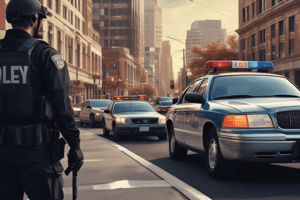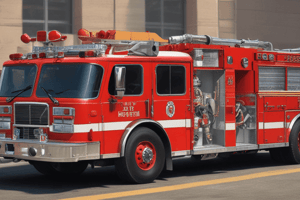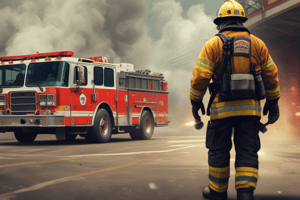Podcast
Questions and Answers
What should a Lieutenant do if they believe an emergency response is necessary?
What should a Lieutenant do if they believe an emergency response is necessary?
- Contact the emergency vehicle operators first
- Notify Dispatch immediately (correct)
- Wait for further instructions from the supervisor
- Assess the situation before acting
What is the protocol when approaching an intersection during an emergency response?
What is the protocol when approaching an intersection during an emergency response?
- Stop completely at blind intersections and stop signs (correct)
- Only adhere to traffic signals if there are no other vehicles present
- Speed through without stopping if the lights are activated
- Reduce speed and proceed without stopping at all times
When is it permissible for an emergency vehicle operator to exceed the speed limit?
When is it permissible for an emergency vehicle operator to exceed the speed limit?
- Whenever they are on a highway
- As long as life or property is not endangered (correct)
- If a Lieutenant authorizes it verbally
- Only if no other vehicles are around
What should an emergency vehicle operator do if they cannot account for traffic in approaching lanes?
What should an emergency vehicle operator do if they cannot account for traffic in approaching lanes?
What is one condition under which an emergency response may be continued without lights and siren?
What is one condition under which an emergency response may be continued without lights and siren?
Under which of the following circumstances must personnel discontinue the emergency response?
Under which of the following circumstances must personnel discontinue the emergency response?
What does 'due regard for life and property' imply for emergency vehicle operators?
What does 'due regard for life and property' imply for emergency vehicle operators?
What action should an emergency vehicle driver take when encountering a red light while responding?
What action should an emergency vehicle driver take when encountering a red light while responding?
What is the primary purpose of the emergency response policy?
What is the primary purpose of the emergency response policy?
Which of the following defines an 'authorized emergency vehicle'?
Which of the following defines an 'authorized emergency vehicle'?
What action should fire personnel take upon being dispatched to an emergency?
What action should fire personnel take upon being dispatched to an emergency?
What is required of personnel when responding with emergency lights and siren?
What is required of personnel when responding with emergency lights and siren?
In the context of multiple emergency vehicle responses, what should vehicle operators be particularly aware of?
In the context of multiple emergency vehicle responses, what should vehicle operators be particularly aware of?
Under which circumstance can emergency personnel respond with lights and siren?
Under which circumstance can emergency personnel respond with lights and siren?
What must personnel do if they are not authorized to respond with emergency lights and siren?
What must personnel do if they are not authorized to respond with emergency lights and siren?
What is the legal reference that outlines the use of emergency lighting and siren?
What is the legal reference that outlines the use of emergency lighting and siren?
Flashcards are hidden until you start studying
Study Notes
Emergency Response Policy
-
The New Lenox Fire Protection District policy ensures safe and appropriate emergency responses while safeguarding department members and the public.
-
The policy mandates that department vehicle operators adhere to Illinois laws and regulations during emergency responses.
Definitions
-
Authorized emergency vehicle: Refers to department vehicles designated as such under Illinois law (625 ILCS 5/1-105).
-
Emergency response: Encompasses various situations requiring immediate action, including fire, explosions, rescues, hazardous materials, natural disasters, and threats to life or property.
Policy Objectives
- The New Lenox Fire Protection District is committed to responding appropriately to all emergency calls.
Emergency Call Procedures
-
Fire personnel dispatched to an emergency must proceed immediately, activate emergency lighting equipment, and sound the siren as deemed necessary (625 ILCS 5/12-601(b)).
-
While using emergency lights and siren, personnel must exercise due caution and drive with regard for the safety of all persons.
-
Responding personnel should only activate emergency lights and siren when dispatched to an emergency or when circumstances reasonably warrant an emergency response.
-
Personnel without authorization to use emergency lights and siren must obey all traffic laws and proceed without emergency lights or siren.
Multiple Emergency Vehicle Responses
-
When multiple emergency vehicles respond, operators must be alert to the presence of other emergency vehicles and exercise caution.
-
Personnel must recognize that traffic yielding to one emergency vehicle may not expect others to follow.
Initiating an Emergency Response
- If a Lieutenant believes an emergency response is necessary, they must notify Dispatch immediately.
Responsibilities of Responding Personnel
-
Emergency vehicle operators must exercise sound judgment and care, prioritizing life and property safety.
-
Emergency vehicle operators should reduce speed at intersections and come to a complete stop at blind intersections or intersections with red lights, flashing red lights, or stop signs.
-
Operators should also stop at intersections where they believe they cannot safely account for approaching traffic or when vehicles have not yielded.
-
After stopping, emergency vehicle operators should proceed only when it is safe.
Emergency Response Procedures
-
Authorized emergency vehicle operators are permitted to perform the following while using lights and siren (625 ILCS 5/11-205(c)(d)):
- Park or stand.
- Proceed past red or stop signals or signs after slowing down as necessary for safety.
- Exceed the speed limit as long as life and property are not endangered.
- Disregard regulations regarding direction of movement or turning.
-
The decision to continue an emergency response rests with either the emergency vehicle operator or the Lieutenant.
-
When road conditions or traffic congestion pose unreasonable risks, the response may continue without emergency lights and siren and at the legal speed limit.
-
Dispatch should be notified promptly if an emergency response is continued without lights and siren.
-
Personnel must discontinue an emergency response when instructed by a supervisor.
Studying That Suits You
Use AI to generate personalized quizzes and flashcards to suit your learning preferences.




